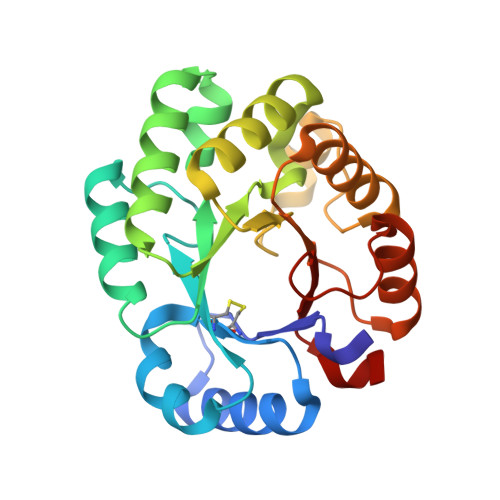Sequential aldol condensation catalyzed by hyperthermophilic 2-deoxy-d-ribose-5-phosphate aldolase
Sakuraba, H., Yoneda, K., Yoshihara, K., Satoh, K., Kawakami, R., Uto, Y., Tsuge, H., Takahashi, K., Hori, H., Ohshima, T.(2007) Appl Environ Microbiol 73: 7427-7434
- PubMed: 17905878
- DOI: https://doi.org/10.1128/AEM.01101-07
- Primary Citation of Related Structures:
1VCV - PubMed Abstract:
Genes encoding 2-deoxy-d-ribose-5-phosphate aldolase (DERA) homologues from two hyperthermophiles, the archaeon Pyrobaculum aerophilum and the bacterium Thermotoga maritima, were expressed individually in Escherichia coli, after which the structures and activities of the enzymes produced were characterized and compared with those of E. coli DERA. To our surprise, the two hyperthermophilic DERAs showed much greater catalysis of sequential aldol condensation using three acetaldehydes as substrates than the E. coli enzyme, even at a low temperature (25 degrees C), although both enzymes showed much less 2-deoxy-d-ribose-5-phosphate synthetic activity. Both the enzymes were highly resistant to high concentrations of acetaldehyde and retained about 50% of their initial activities after a 20-h exposure to 300 mM acetaldehyde at 25 degrees C, whereas the E. coli DERA was almost completely inactivated after a 2-h exposure under the same conditions. The structure of the P. aerophilum DERA was determined by X-ray crystallography to a resolution of 2.0 A. The main chain coordinate of the P. aerophilum enzyme monomer was quite similar to those of the T. maritima and E. coli enzymes, whose crystal structures have already been solved. However, the quaternary structure of the hyperthermophilic enzymes was totally different from that of the E. coli DERA. The areas of the subunit-subunit interface in the dimer of the hyperthermophilic enzymes are much larger than that of the E. coli enzyme. This promotes the formation of the unique dimeric structure and strengthens the hydrophobic intersubunit interactions. These structural features are considered responsible for the extremely high stability of the hyperthermophilic DERAs.
- Department of Life System, Institute of Technology and Science, University of Tokushima, 2-1 Minamijosanjima-cho, Tokushima 770-8506, Japan.
Organizational Affiliation:

















